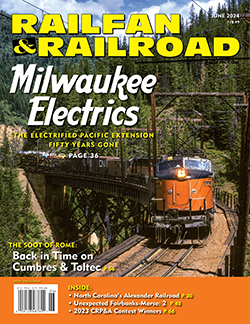In North America, heavy electric main lines outside of the East Coast are relatively uncommon. During the early 20th century, when many European railways began to string up wire, most American lines doubled down on buying bigger and better steam engines. As steam began to fall out of favor at mid-century, most roads modernized with diesels.
This is not to say that there were no electrically propelled railways on the continent. Streetcars, trolleys, and interurbans appeared on the scene in the 1890s, ushering in a boom era of electric railways in North America. Transit lines in major cities, such as subways and commuter rail lines, were often electrified not only to cut down on pollution but to take advantage of the efficiency of electric traction to accelerate between frequent station stops.
Industrial operations took advantage of electricity as well, either as tiny narrow gauge trains working at steel mills or diving deep into mines, or heavy rail applications such as working an open pit or carrying coal to a power plant.
It was the New Haven that embarked on the first large-scale main line electrification in 1907, completed in 1914 (with additional branches energized through the 1920s). Mighty Pennsylvania Railroad took lessons and electrified its main line from New York to Washington, D.C., in the 1920s (the two routes were linked by Hell Gate Bridge in 1918). Farther south, Virginian Railway made use of the high tractive effort of heavy electric locomotives to haul coal from the Appalachians to the tidewater port of Norfolk in 1925.
It is The Milwaukee Road, however, that stands out as the continent’s most picturesque electrified main line (page 36). In the early years of the 20th century, The Milwaukee Road extended from its Midwestern network out to the Pacific Coast, becoming a transcontinental in its own right. Within a few years, the company began a massive upgrade to the latest technology — electrification.
This was a pragmatic, long-term investment, but also a statement to the world — The Milwaukee Road was a thoroughly modern railway. Conversion began in 1914, starting in central Montana and moving westward over the Continental Divide. This was followed by electrification of the company’s route over the Cascades in Washington state. These two electrified segments, however, were never connected, leaving a 212-mile “gap.” Trains to the Pacific Coast would have to change locomotives not once, not twice, but three times each way.
The financial viability of the (mostly) electrified Pacific Extension is debatable. It had been built into a territory already served by two other companies. Construction costs had been nearly double the initial projections, and electrification had only added to this expense. Historians continue to debate whether the extension ever earned back its initial investment at all.
What we do know is this — money was never so flush as to fill in the gap, and new electric locomotives were few and far between. As a result, the Milwaukee acquired a scrappy, make-do culture. As time passed, what had once been a symbol of the road’s modernity had taken on the patina of anachronism. Studies were made to modernize, but in a desperate move to keep the system alive the wires came down for good in 1974. It was not enough; in spring 1980, the Pacific Extension itself would disappear, much of its tracks ripped up. Today, in the Coulees of eastern Washington, and the Bitterroots and Big Sky country of Montana, the oversized, seemingly lost legend of The Milwaukee Road’s electric motors is a fading memory.
—Alexander Benjamin Craghead is a transportation historian, photographer, artist, and author.
This article appeared in the June 2024 issue of Railfan & Railroad. Subscribe Today!
The post The Rise and Fall of Electric Main Lines appeared first on Railfan & Railroad Magazine.
